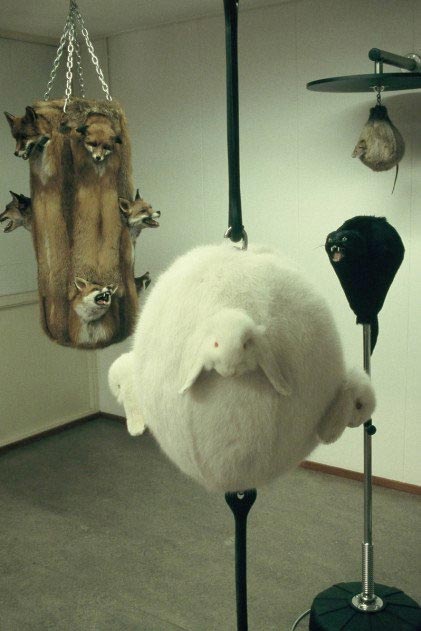The birth of wisdom
For the past 150 years, MIT has been leading us into the future. The discoveries of its teachers and students have become the warp and weft of modernity, the stuff of daily life that we now all take for granted. The telephone, electromagnets, radars, high-speed photography, office photocopiers, cancer treatments, pocket calculators, computers, the internet, the decoding of the human genome, lasers, space travel… the list of innovations that involved essential contributions from MIT and its faculty goes on and on.
And with that drive into modernity MIT has played no small part in building western, and particularly US, global dominance. Its explosive innovations have helped to secure America’s military and cultural supremacy, and with it the country’s status as the world’s sole superpower.
{ Guardian | Continue reading | video via copyranter }
The movements of deconstruction do not destroy structures from the outside
Scientists have tested the old Danish myth that it is possible to get drunk by submerging your feet in alcohol. (…)
The researchers submerged their feet in washing bowls containing three 700mL bottles of vodka (37.5% by volume). They then recorded the level of drunkenness using the concentration of plasma ethanol and a more interesting secondary outcome. (…) “The secondary outcome was self assessment of intoxication related symptoms (self-confidence, urge to speak, and number of spontaneous hugs).”
The results of the blood plasma ethanol levels were all below the detection limit of 2.2 mmol/L and the secondary outcome results were deemed not significant. Although they did observe that after the experiment the skin on the researchers feet was ‘clean and smooth’.
Spew revisionist shit all you want.

How appropriate that you had to use someone else’s joke to take a swipe at me. I told you my idea. You did it two weeks later, VERBATIM. Spew revisionist shit all you want. Everyone knows you’re a hack. Also, everyone knows how you fucked over Paul Feig on the new show. All your press mentions “your” brilliant “Freaks and Geeks,” as if Feig didn’t even do the series. It must have killed you when the true genius behind it got nominated for an Emmy. Is your wife still livid about someone in the neighborhood building a house just like hers? Tell her I know how she feels. The reason I called was to tell you to piss off. We’ll never be “friends,” regardless of the pussy whining from your last email. I respect you zero.
{ From an exchange of emails in fall 2001 between Judd Apatow, the creator of the sitcoms Freaks and Geeks and Undeclared and a successful writer of Hollywood screenplays, and Mark Brazill, the creator of That ’70s Show. | Harper’s magazine | Continue reading }
artwork { Joe Heaps }
Tell your girlfriend I said thanks
Television showrunners are notorious multitaskers, with the most successful able to toggle easily between the roles of CEO and auteur. But Louis C.K.’s work on Louie requires a whole different level of personal oversight. The show is based on his life. Louis is the director. He’s also the only writer, the sole editor (he no longer shares duties with the co-editor he had last season), not to mention the person who oversees music (when the music guy’s budget ran out, he decided to do it himself). He also hired his own casting team: Last season, he turned down FX’s offer to help out and doesn’t inform them about casting in advance. But perhaps the most unusual aspect of the show is that Louis C.K. gets no notes from the network during filming, no script approval—an unheard-of “Louis C.K. deal” that has made him the envy of comics and TV writers alike.
A ring around the finger does not cause a nerve block to the genitals
A meta-analysis finds gender differences in sexual attitudes and behaviors are smaller than you may think. (…)
Synthesizing the results of more than 700 studies, psychologists Jennifer Petersen and Janet Shibley Hyde of the University of Wisconsin-Madison report “men and women are more similar than they are different in terms of sexuality.” They found only small differences between males and females in 22 of 30 common sexual behaviors and attitudes — and no differences at all for another four.
The sexual behaviors surveyed included frequency of intercourse, number of partners, extramarital sex and condom use. A separate list examined sexual attitudes, including permissiveness, anxiety and guilt, satisfaction with one’s sex life and views regarding homosexuality.
The researchers found substantial gender differences in two categories: reported masturbation and pornography use. (…)
Overall, the report provides at least qualified support for several theoretical models — including evolutionary psychology, which contends that men have evolved to desire multiple sex partners because it increases their odds of passing their genes down to the next generation. (Women, on the other hand, “have evolved to disapprove of casual sex because it may yield fathers who do not provide for them and their children.”) The fact that men reported more permissive sexual attitudes and engaged in more sexual behavior is consistent with this notion.
related { Women who are sexually satisfied are also happier, no matter their age, a study suggests }
‘Different men may be differently affected by the same object, and the same man may be differently affected at different times by the same object.’ –Spinoza

One of the things I asked him was is a computer going to create Beethoven’s 10th Symphony? What is the role for creativity? I think Robin and others would say: Well, we romanticize that. It’s still just neurons firing. A great chess player we think of as an artistic genius, but a great computer has now surpassed almost all of the great chess players. Just again a matter of romance and time before we eliminate this idea that there is something more than the brain.
I have a number of comments. One is that when we say, to take the particular example we always use, that computers play great chess, first of all I would claim there are actually two games there. There’s computer chess and human chess, and it isn’t exactly the same game. Humans play chess very differently than computers. In a certain sense you are comparing apples with oranges when you claim that. You want to stop and explain that? What happens is computers, because they have such a large memory capacity, and they do very simple operations so quickly, they can go through literally millions of possibilities in a very short amount of time. Human beings cannot do that, so they have to rely on other capacities they have that the computer doesn’t have, things like intuition, judgment, and feel. Things which are difficult to quantify. In fact, human beings have all these capacities which are essentially non-quantifiable: That is to say, we have parts of our brains that operate non-digitally.
photo { Jean-Michel Basquiat photographed by Andy Warhol, 1984 }
Travis Bickle: Now I see this clearly. My whole life is pointed in one direction.

Burundanga is a scary drug. (…) The scale of the problem in Latin America is not known, but a recent survey of emergency hospital admissions in Bogotá, Colombia, found that around 70 per cent of patients drugged with burundanga had also been robbed, and around three per cent sexually assaulted. “The most common symptoms are confusion and amnesia,” says Juliana Gomez, a Colombian psychiatrist. (…)
News reports allude to another, more sinister, effect: that the drug removes free will, effectively turning victims into suggestible human puppets. Although not fully understood by neuroscience, free will is seen as a highly complex neurological ability and one of the most cherished of human characteristics.
{ Wired UK | Continue reading }
Neuroscientists increasingly describe our behaviour as the result of a chain of cause-and-effect, in which one physical brain state or pattern of neural activity inexorably leads to the next, culminating in a particular action or decision. With little space for free choice in this chain of causation, the conscious, deliberating self seems to be a fiction. From this perspective, all the real action is occurring at the level of synapses and neurotransmitters.
For now most of us are content to believe that we have control over our own lives, but what would happen if we lost our faith in free will?
oil on canvas { Aron Wiesenfeld, The Wedding Party }
Alright, where’s Vicious Lee?

{ Hulton/Deutsch Collection/Corbis }
Every day, the same, again
 Four injured in iPad fight at Beijing Apple store.
Four injured in iPad fight at Beijing Apple store.
Heat generated by cremating bodies could be used to warm up people using a swimming pool in UK.
German man trapped in women’s prison rescued by mayor.
A prison guard dog has been fitted with titanium teeth in Australia after losing his real ones.
Long Island killings: Detectives began looking at the NYPD cops last month after determining the killer likely worked in law enforcement or was familiar with police techniques.
48% of Fast Food Soda Fountains Contain Bacteria that Grew in Feces.
Man steals restaurant tips, then is hit by bus as he flees.
Ohio Boys Suspended For Farting On School Bus.
 Can we be awake and asleep at the same time?
Can we be awake and asleep at the same time?
How the Illusion of Being Observed Can Make You a Better Person.
There is a conflict between your immediate gut instincts and your more longer-term goals to stay committed to your partner. Why Do People Resist the Temptation to Cheat?
Getting along with co-workers may prolong life, researchers find.
How the brain processes complex beliefs in the domains of morality, religion and politics.
More than 20 percent of atheist scientists are spiritual.
Musical experience offsets some aging effects. Lifelong musical training appears to confer advantages in at least two important functions known to decline with age — memory and the ability to hear speech in noise.
The Science of Starvation: How long can humans survive without food or water?
Cats pass disease to wildlife, even in remote areas.
How synthetic biology will bring us cheaper plastics by ruining the poorest nations on Earth.
 International Journal on Human-Computer Interaction.
International Journal on Human-Computer Interaction.
A new system in San Francisco learns from the past to predict traffic jams before they happen.
Robert X. Cringely and Jean-Louis Gassée on Why Microsoft bought Skype.
The DOJ’s online-poker shutdown leaves a pro player to wonder how he’ll make a living. For most of the last six years, my daily routine consisted of waking up in the morning and playing online poker tournaments.
Her death is a suspected suicide by jumping from the building site next to her ninth-floor apartment. No signs of a struggle detected. No alcohol or drugs in her blood or urine. She left no note. She was 20. She landed 8.5 meters from the building. Why did a supermodel at the top of her game—hauntingly beautiful and only 20—kill herself in 2008?
Meet Edward Tufte, the graphics guru to the power elite who is revolutionizing how we see data.
Spencer Tweedy — blogger, photographer, musician, and 14-year-old son of Wilco frontman Jeff Tweedy.
By far, most of the traffic from links comes from the sprawling hybrid of Google search and news, which provides about 30 percent of the visits to news sites. And the second?
Despite their apparent contradictions, however, postmodern histories have been written. This article deals with one such attempt, The Witch in History (1996) by Diane Purkiss. The work is a perfect representative sample of postmodern history because it (a) is not written by a historian, and (b) does not make use of historical evidence to prove its point.
Why is the vampire Edward Cullen from Twilight desirable despite being an extreme psychopath?
Think of all the female protagonists in Disney musicals. There are quite a number—Cinderella, Belle, Pocahontas. Now think of female protagonists in Pixar movies. There aren’t any. Not a single one.
Essay on The Faux-Vintage Photo (Instagram, Hipstamatic, etc.)
Implied motion in Hokusai manga.
Part 1: Desire and Causality in Road Runner Cartoons. Part 2: Reason Harnesses the Social Mind: Road Runner II.
 America’s Top 10 New Sandwiches.
America’s Top 10 New Sandwiches.
The banana is threatened by Panama disease race 4, a fungus that spreads through the soil. Are bananas about to become extinct?
The Food Lab’s Top 6 Food Myths.
How to Extract Ink From an Octopus.
Why do fake phone numbers start with 555?
Why is the Bronx called THE Bronx?
List of countries without armed forces.
What Made The AK-47 So Popular?
The Complete Guide to Not Giving a Fuck.
A graphic example of why you should never let a relative illustrate your hair salon sign.
Mad at Diesel. [via copyranter]
Dual Hercules Salvo. [video]
I was born in North Dakota a long time ago, see. And now I’m lucky enough to be here with you.
Dr Bryan Caplan, an academic and economist from George Mason University in Virginia, believes parents are working far too hard at bringing up their children. (…)
“Quit fretting over how much TV your kids watch. Don’t force them to do a million activities they hate. Accept that your children’s lives are shaped mostly by their genes and their own choices, not by the sacrifices you make in hopes of turning them into successful adults.”
Caplan points to scientific evidence to support the idea of “serenity parenting.” Research on twins and on adopted children shows, he says, that parents’ long-term effects range from small to zero for a wide range of outcomes such as health and success. (…)
Research also shows that a child’s intelligence can be increased by parental interaction when they are very young, but by the time the child reaches 12 the effect has disappeared.
{ Guardian | Continue reading | More: Bryan Caplan on Parenting | EconTalk | Audio + Transcript }
Mr Ness. Scorpio. My name’s right here.
If your doctor recommended a drug whose manufacturer’s consulting fees financed his summer home, would that give you pause? Would you trust a stockbroker who wanted to sell you on a risky mutual fund that gave him a commission for every sale? (…)
Within many fields, one solution has emerged: require people to disclose any ties that might sway their judgment. Such transparency, the rationale goes, encourages those in authority to behave more ethically.
But recent research by experimental psychologists is uncovering some uncomfortable truths: Disclosure doesn’t solve problems the way we think it does, and in fact it can actually backfire.
Coming clean about conflicts of interest, they find, can promote less ethical behavior by advisers. And though most of us assume we’d cast a skeptical eye on advice from a doctor, stockbroker, or politician with a personal stake in our decision, disclosure about conflicts may actually lead us to make worse choices.
This is what Cinderella’s godmother gave to her when she taught her to behave like a queen

{ Apple overtook Nokia last quarter to become the world’s No. 1 vender of mobile phones — smart or otherwise — in terms of revenue. In terms of sales, it still has a lot of room for growth. | Fortune }
I bought a doughnut and they gave me a receipt for the doughnut. I don’t need a receipt for the doughnut.
more { d’Eon & Grimes’s Darkbloom }












